This article contains affiliate links.
My quest to continue down the rabbit hole of pistol dot options continues. A while back I took a look at the Shield SIS2, a compact red dot sight intended for small rifles or piggybacking on larger optics. The SIS2 originally rode on my B&T GHM9, but since writing that review I went ahead and mounted on top of my Elcan Specter.
After a smooth experience with an RMA with Shield, the SIS2 has been great, and I was sufficiently impressed with it that I wanted to explore more of the Shield lineup. About the same time I discovered the SIS2, I noticed that Shield had a page on their site dedicated to two new enclosed pistol dot options. The AMS for full-size pistols, and the AMSc for compact and sub-compact pistols. Both rely on the same RMSc footprint, which is nice, so the main difference between them comes down to overall size of the housing and windows.
Bottom Line Up Front
Before getting into the weeds, let’s lay out my thoughts up at the top. I purchased the Shield AMS on sale with my own funds. After 500ish rounds through it, I think it’s a really good entry into the enclosed pistol dot market, especially if you’re trying to keep to the RMS/RMSc footprint. Brightness is great, and I like the option to use the excellent auto brightness settings as well as selecting between 12 levels manually. The optic has no visible tint whatsoever, which makes a difference to me as far as enjoyment goes.
For downsides, I have two things that hold it back from being an absolutely fantastic optic. First, the battery life lags competitiors at 13,000 hours for the smallest battery option and 25,000-ish for the largest (yes, you can choose between different battery types). That’s still more than a year of life on average use with the smallest battery, but competitors from Holosun and Sig simply do better. I suspect the fact that Shield has never implemented an auto-shutoff and shake awake is part of that.
Secondly, the Shield AMS has a pronounced tunnel at the bottom. There’s a window at the rear of the tunnel that you can cowitness standard height irons with. The reason for this tunnel has to do with the placement of the optic’s emitter relative to the main housing and lenses, and it’s unavailable in its current electronics package. The tunnel is fine, and didn’t actually bother me much at all in use- but it’s something to be aware of.
In all, if you’re hunting for an enclosed pistol optic from a reputable company that’s designed for duty use and isn’t made in China, well this is a great option.
The Shield AMS
Looking for an enclosed emitter optic that was suited to my CZ P10F or maybe direct milling to my P07, I opted for the AMS- which stands for Advanced Mini Sight.
While I saw this optic on Shield’s site last year, and a presentation at SHOT Show 2024, they never really hit the market until later in the year. The lag time was so long that they did a whole new press release around SHOT Show 2025 as if it was a new product.
I found a deal on the AMS from Midway USA for $397.49 in January, and snatched it up using my own money. Given the MSRP is $599.99 on the thing, that seemed like too good of an opportunity to pass.
A few days later, the optic arrived in very similar packaging to the SIS2. A basic cardboard wraparound holding a plastic clam shell case. In the box was the optic, optic cover, battery, two sets of mounting screws, wrenches, a zeroing tool, three sets of battery caps, a shim, stickers, and a business card with a QR code taking me to the online mnanual.
Why multiple battery caps?
The AMS allows you to use either CR2025, CR2032, or CR2050 lithium coin cell batteries. The larger the battery, the bigger the cap to hold it. This lets you choose your own balance between battery life and how large of a cap you want to deal with for concealability.
Overall, the AMS looks like a smaller version of the SIS2, with nearly identical design cues in many places, identical controls on the left side, and even the same reticle selection options.
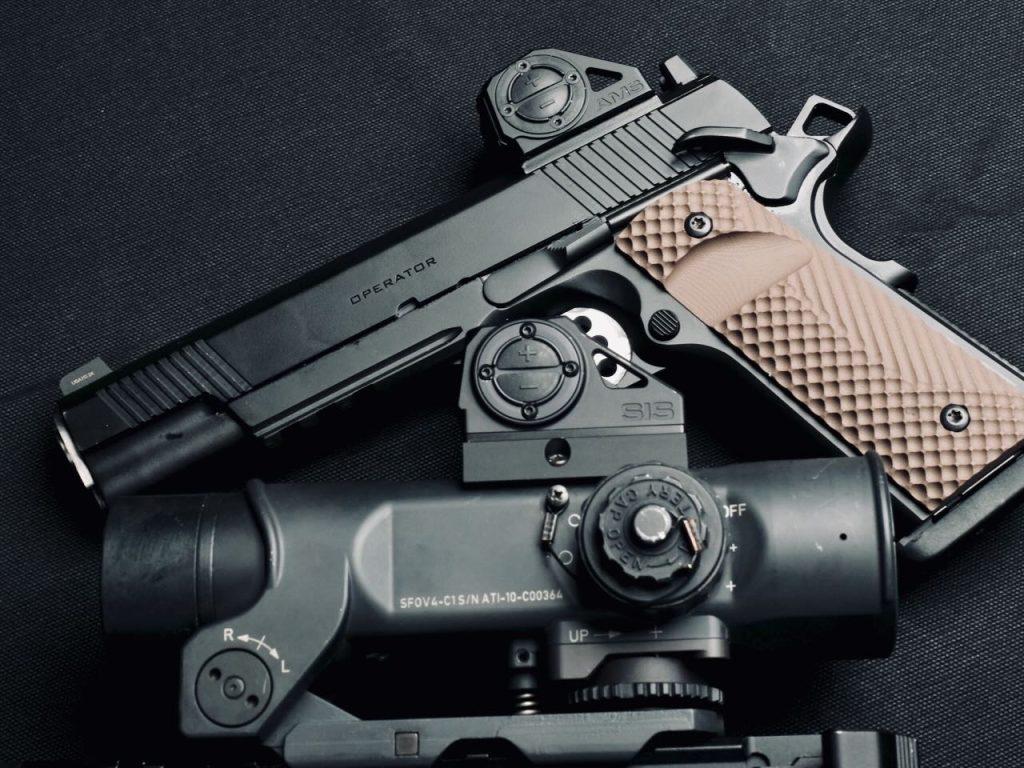
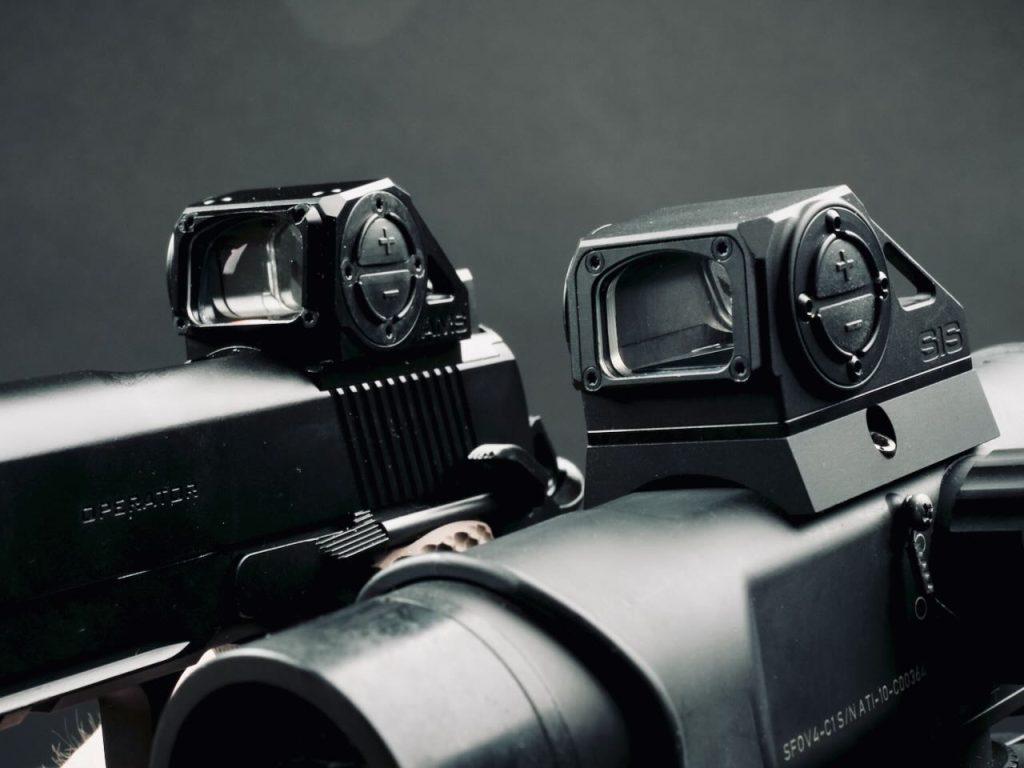
Key Specs
Here are some key specifications for review.
| Item | Value |
|---|---|
| Country of Origin | United Kingdom |
| Housing material | “Aerospace-Grade” Aluminum (likely 6082) |
| Weight | 1.3 ounces, not including battery |
| Overall dimensions (measured with calipers) | 1.6″ (L) x 1.32″ (W overall) x 1.0″ H; The base is 1.1″ wide at narrowest point |
| Front window dimensions | 0.85″ (W) x 0.63″ (H) |
| Rear window dimensions | 0.84″ (W) x 0.62″ (H) |
| Mounting footprint | Shield RMS/RMSc |
| Battery life | 20,000 hours with CR2032, 13,000 with CR2025 |
| Reticle options | 2 MOA dot, 8 MOA dot, or either one with 65 MOA ring |
| Water resistance | 30 feet for 30 minutes |
| Brightness settings | 12 manual, including 3 NV Also 3 auto brightness modes |
| Zeroing adjustment | No click values, adjustment freely movable without clicks |
| Optic style | Enclosed emitter LED, clear polycarbonate lenses |
First Impressions and Mounting
Out of the box, the AMS gives a very similar vibe to the Shield SIS2. It feels quality, with a thick aluminum housing, yet low deck height. It gets to a very high brightness, and the lens has no visible tint at all. Surrounding the front lens is a 0.08″ stand-off to protect it from damage if you were to use the optic for cycling the slide or anything like that.
Perhaps the most conspicuous thing about it is the obvious “sight tunnel” at the bottom of the window. When I first saw this in the advertising photos and in person, I wasn’t sure what Shield was thinking. It just looks a bit…awkward.
The deck height of the Shield AMS is indeed low enough that you can use standard height irons on a pistol. Personally, I think this is the best avenue for pistol optics as it keeps your draw and presentation nearly the same between optics and iron sights. This is a good thing. But why did Shield feel compelled to build this peep sight-looking tunnel to aim through?
My first guess was that it was meant to serve as a rudimentary rear iron sight for people who had to delete their rear sights in order to mount an optic. To that end, I suspect it would work reasonably well. But if you aren’t in that bucket, and your pistol has a complete set of sights, it’s a bit of a different story.
Why They Did It
I mounted the Shield AMS to my CZ P10F at first. I ran about 300 rounds through it in this configuration, and also shot the January/February 2025 postal match with it. The P10F has standard height irons, and I could get a perfectly usable iron sight picture through the little tunnel.
After that, I mounted the AMS to my recently-purchased Springfield 1911 Operator AOS. The Operator AOS has taller sights. Not quite suppressor height, but also not standard low height. This combination proved to be an issue, as the little sight tunnel on the AMS has a cone shape to it that widens as it moves forward. The tunnel looks thicker than it actually is when viewed from behind, and the top of it gets in the way of a proper iron sight picture with the intermediate height sights.
So, again, I tried to figure out why they did it?
By chance, my friend Ilya (The Dark Lord of Optics) also happened to be using both the Shield AMS and the compact AMSc. I posed the question to him, and he gave me the engineering answer- and I felt dumb for not realizing it myself.
Ilya pointed out that that Shield had an engineering problem to solve. They use a standard footprint for their sights (RMS & RMSc), and have a fairly standard electronics package that places the emitter in between the two mounting screws. This gives them a nice long distance between the emitter and the front lens. By having this longer distance, it improves the optical qualities of the sight, particularly the collimation quality.
Collimation?
So what is collimation? I’m not an optical physicist like Ilya, so this is my best understanding. The best way to think about collimation is that it refers to aligning beams of light so that they are as parallel as possible. In telescopes, good collimation means having the mirrors and lenses aligned properly, which contributes to higher image quality. In red dot sights, it’s about the angle of the emitter beam bouncing off of the front lens and back towards your eye. The closer the emitter, the more dramatic an angle the front reflector must be in order to bounce the light back to you. The more dramatic this reflector angle, the more you have to contend with distortion of the image (and dot) as well as parallax issues.
All of that to say that Shield has great optical qualities in their dots because they use a fairly long distance between the emitter and reflector. This created a problem for Shield. If they built the housing so that the rear lens encompassed the emitter, it would be behind the mounting screws, which means you couldn’t mount the thing.
So they took a creative route. Shield built the main housing of the AMS to have the rear lens in front of the mounting screws, and then constructed an additional housing around the emitter that merged into the main structure. Since it was in the way of the irons, they just added another lens to the rear of it so you could see through it.
Competitor Options
So what does the AMS compete with? There are several other options, like the long standing Aimpoint ACRO, Steiner MPS, Trijicon RCR, and more. But for simplicity sake, I’ll just focus on the ones that also share the RMS/RMSc footprint (or very close to it). That limits the conversation to the Sig Romeo-X Compact Enclosed, Holosun EPS, and Meprolight MPO PRO-S. I don’t have direct experience with any of these, so this isn’t a full comparison.
The Sig Romeo-X Compact Enclosed and Holosun EPS both look like they take a route of moving the emitter much closer to the front lens so that it sits inside the rear lens. In effect, they are compromising on the collilmation quality versus the Shield AMS. The Mepro MPO PRO S took a different route by having a mounting plate that attaches to an RMSc footprint, and then the optic appears to clamp onto the mounting plate much like the Aimpoint ACRO and Steiner MPS.
The Mepro is an interesting solution as it allows the emitter to be further away and still enclosed, but it also adds even more additional height to the mounting. The AMS, Sig, and Holosun all mount low enough to allow standard iron sight cowitness. The Mepro does not.
Shield AMS Mounting and Performance
Mounting the Shield AMS works just like any other optic. For the CZ P10F, I picked up an RMS optic plate made by Eemann Tech. Then, later, for the Springfield Operator AOS, I grabbed Springfield’s 12B AOS plate. Both were uneventful (and I quite like the Springfield AOS system for their 1911s, but that’s for another day).
The AMS comes with two sets of screws, each pair a different length to account for various mounting plates and pistols. They mount with a 2.5mm hex wrench. I tend to mount my optics with Vibra-Tite VC3 Threadmate, and it’s always worked well for me. No issues here.

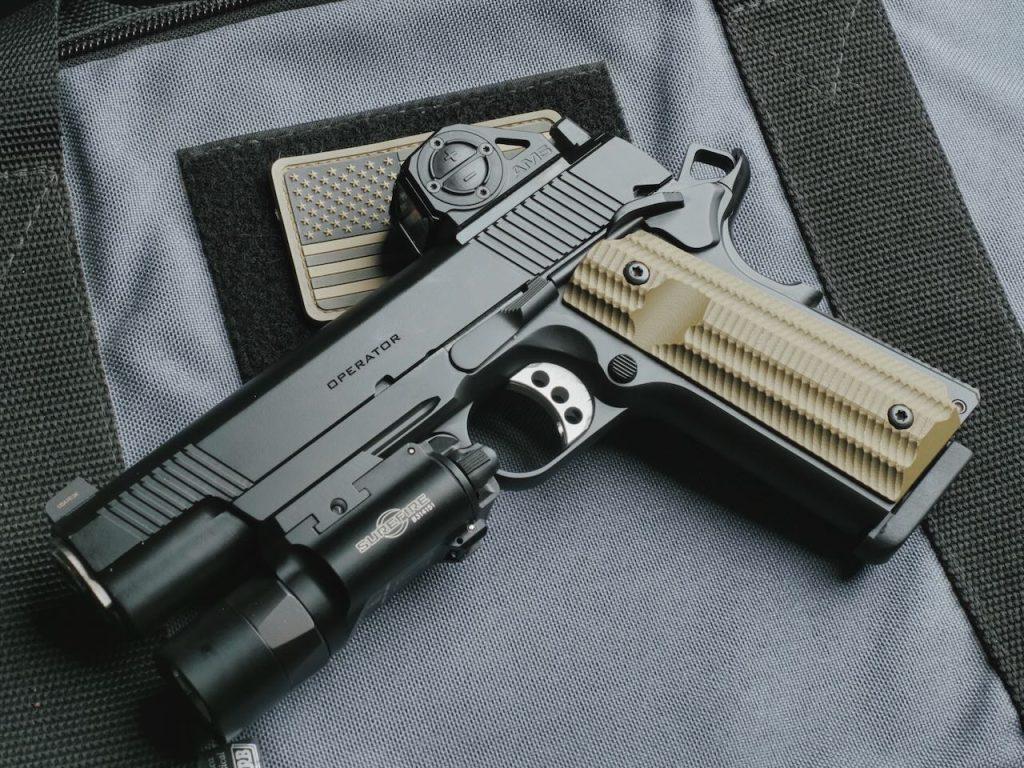

AMS Illumination
The Shield AMS has twelve brightness settings, with the bottom three intended for night vision. You can cycle through these settings manually by pressing the “+” or “-” buttons on the left side of the housing. The AMS also has an automatic brightness functionality. What I found interesting here is that there are three automatic brightness “brackets.” By that, I mean that you can choose which bracket to use by putting the optic into auto mode and then using “+” or “-,” and then the automatic mode will hold the brightness at roughly the same level. Think of it like sectioning out the brightest four settings, the middle four, and the bottom four, and then telling to optic to stay within one section. Tapping the button moves you up or down a bracket.
I like this, because it solves a common issue of challenging lighting situations like quickly going indoors and outdoors, or being indoors and then pointing at something in a brighter area. In all, I’ve found the automatic brightness mode to work well and it is very responsive.
The illumination gets very bright, and I’ve had no issues at all with the dot washing out.
As a possible downside, I do think the AMS has a slightly slower refresh rate. Something I’ve noticed about all of my shield sights (SIS2, this AMS, and an RMSx I also recently picked up for review) is that when I shake them quickly from side to side, I can see a clear pattern of dot-dot-dot-dot-dot or line-line-line-line-line, as if it was Morse code. This pattern is a result of how the sight modulates power to the emitter to control brightness.
I do not see this same thing on my Trijicon SRO, Holosun 507c, or Mepro MPO-F.
With the shield sights, I don’t notice it at all while statically aiming at a target, but it becomes more apparent when I’m swinging the pistol from target to target and my brain is trying to keep up with the visual picture. The dot appears to “stutter” a bit if I’m keeping a target focus, but not when I focus on the dot during the movement. We’ll see how this plays out in the long term.
Shield AMS Reticles
The AMS uses the exact same reticle options as my SIS2, and cycling between them is exactly the same process. You have the option of a center aiming point that’s 2 MOA or 8 MOA. Then you have the option to place a 65 MOA dotted ring around the center dot. I found the ring to be an interesting option on a long gun or PCC, but frankly find it a bit pointless on a pistol due to the smaller viewing window and distance from my eye. Perhaps if I mounted it as a piggyback on larger rifle optic- but then I would opt for the SIS2, anyway.
Zeroing and Sight Adjustment
While the SIS2 uses a larger adjustment screws with slots for easy changes, the AMS has very small hex key adjustments. My calipers measured the flats at 0.058″, so I suspect they are officially 0.05″. There is one on top and one on the side for elevation and windage.
As with other Shield sights, there are no clicks. The adjustments have enough resistance to stay put, but when you start turning them they just go smoothly with no physical indication of how far you’ve moved them. Shield did include a small “Minidial” wheel that fits around the key. The dial has a series of hash marks around the perimeter, like a clock, each one indicating 1/4″ of adjustment at 20 yards.
Honestly, I didn’t bother with the dial. I set my target at 15 yards, fired a group, and made adjustments as needed until my POA and POI lined up.
Since the adjustment screws are so small, there’s not really any room to put witness marks, either.
In all, this system is…fine. It’s probably my least favorite thing about shield sights, and they seem to do it on everything. Their argument is that it allows for “infinitely fine adjustments.” I personally think that we’re dealing with such small angular values here that I would rather have an easy way to count adjustments and a modicum more peace of mind that it won’t move anywhere after I set it.
Testing the AMS
As mentioned, I ran 300 rounds through my CZ P10F with the AMS mounted on top. I thought the AMS was a great fit for this gun, especially if it was oriented towards duty use. The sight did not overhang the sides of the CZ slide much, if at all, and the factory standard height irons worked well through the emitter tunnel at the bottom of the housing.
I shot the January 2025 postal match with this setup, and posted a decent score of 257. The optic worked great, and I appreciated the various brightness levels for my local indoor range.
The housing itself is thick, with the top being very thick when looking through the optic. On the one hand, it presents the feeling of toughness and durability (which is good for a duty optic), but it was a little bit distracting compared to what I’m used to with the Trijicon SRO.
Because of the smaller window, relative to the SRO, I also found myself having a little bit more trouble locating the dot upon presentation. This is a practice issue, though, not the fault of the optic itself. The AMS has a window size on par with other competitor duty optics like the RMR. In fact, the AMS’s front window is practically the same dimensions as the RMR and Steiner MPS, and all three are bigger than the Aimpoint ACRO.
After those 300 rounds riding on the P10F, I mounted the AMS to the Springfield Operator AOS in 9mm. Here, I ran it through another 250 rounds, where it again performed flawlessly. The only issue I had, which again is not the optic’s fault, is that the front lens got fouled up with carbon and junk from the pistol coming out of the little notch at the rear of the barrel hood that Springfield uses as a loaded chamber indicator. Despite the image eventually becoming obstructed from the debris, the dot still worked just fine with both eyes open.
As an aside, the AMS is just slightly too wide for a 1911 slide. The mounting plate and everything works just fine, but since a 1911 slide is relatively narrow, the optic overhands the sides by 0.11″ on each side. It’s not totally obnoxious, but it’s obvious.
Shield AMS Conclusions: Is it Worth It?
We’re lucky that there are so many good choices for duty-ready optics. The biggest question is choosing one that fits your preferred footprint. Many pistols come from the factory with a set mounting footprint like RMR or RMSc. In those cases, you’d probably want to pick the one that matches for you. The AMS is a great entry for anything that has the RMS/RMSc footprint. For a very narrow slide, like a 1911, or a sub-compact pistol, then I’d look more at the smaller AMSc.
So what sets the AMS apart from its primary competitors for me? First, I think the most obvious thing is the very clean optical sight picture. I don’t know of any other mini dot optic that has zero tint in the lenses like this. If you find blue-ish tint in optics to be distracting, then the Shield should already climb to the top of your list since it has none.
Second, while I didn’t put it through a Sage Dynamics-like torture test, the optic certainly feels like it’s built to take a beating.
I also like that you have the choice of dot sizes and reticles. Some people like fine dots for precision, and others prefer something larger for more speed. In this case, you don’t have to choose between different optics since you can do both in the same one.
What are the drawbacks?
First, the cowitness tunnel is a little…meh. I get that there wasn’t really a way around it given Shield’s standard electronics package, but it just seems to fit such a narrow niche of pistol sights. It was okay on my P10F, but it’s too tall for my 1911. It might be ok on suppressor-height sights, but it might not. I can’t help but wonder if there was a better way to approach that problem.
Second, compared to competitors, Shield’s power management seems slightly behind the curve. 20,000 hours is perfectly adequate for the real world, but it just lags others. They don’t have any sort of auto-shutoff or motion activation, which would further help with battery life.
Last, the refresh rate of the emitter itself might just be a hair to slow. I still find it perfectly usable, but it’s noticeably more “choppy” than my other non-shield optics.
Final Thoughts
At a full MSRP of $599.99, the Shield is fine. I’d be carefully comparing it against other premium and well-known options. But if you can find one on sale for less than $400 like I did, then I think it’s a n-brainer. This is doubly true if you’re trying to avoid optics made in China. Shield seems to have built themselves a nice little product and fills a niche that I don’t think many others are doing well- especially when it comes to a dot that sits low enough for you to also use your standard iron sights.
So, to sum up, I think it’s a great sight if it fits your particular niche and you’re using standard low profile iron sights. If you don’t mind buying from China, then the Holosun EPS is likely another very compelling option for you to shop against at a similar price point (when the Shield is on sale) and with a similar footprint. Note that the Holosun EPS footprint is actually their “k” footprint, which is a modified RMSc.
For now, I’ve replaced the AMS on my 1911 with the Shield RMSx. I’m sufficiently happy with the AMS that I think I’ll have my P07 milled for direct mounting with it. That should probably be a good indicator of how I feel about it.




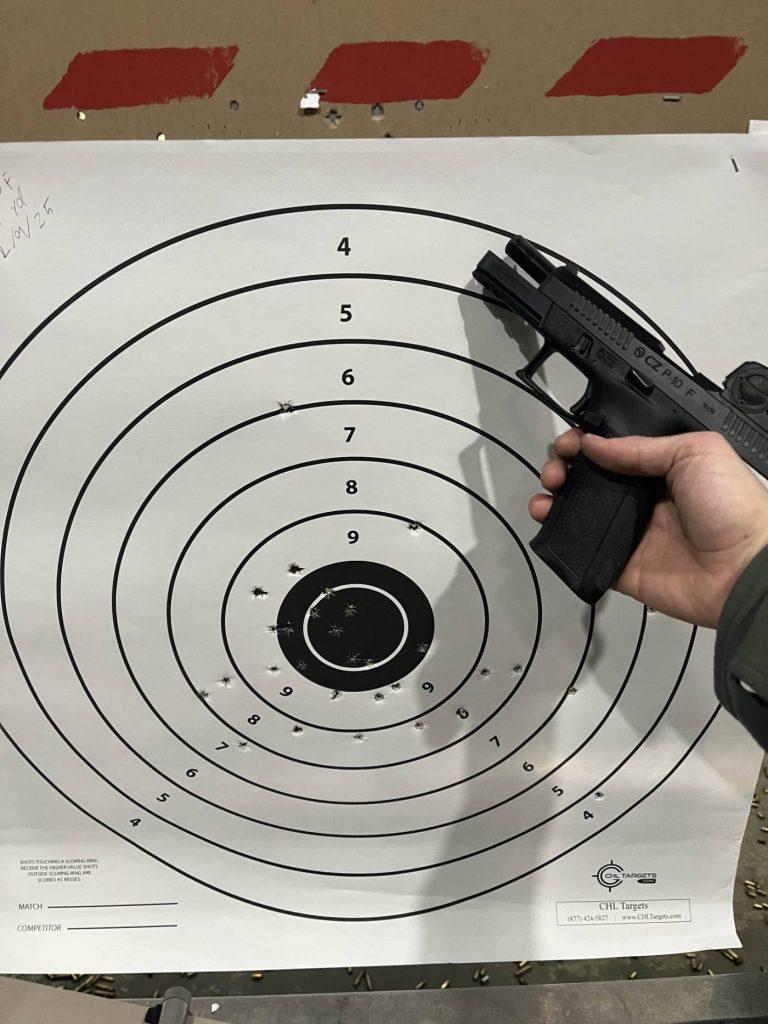
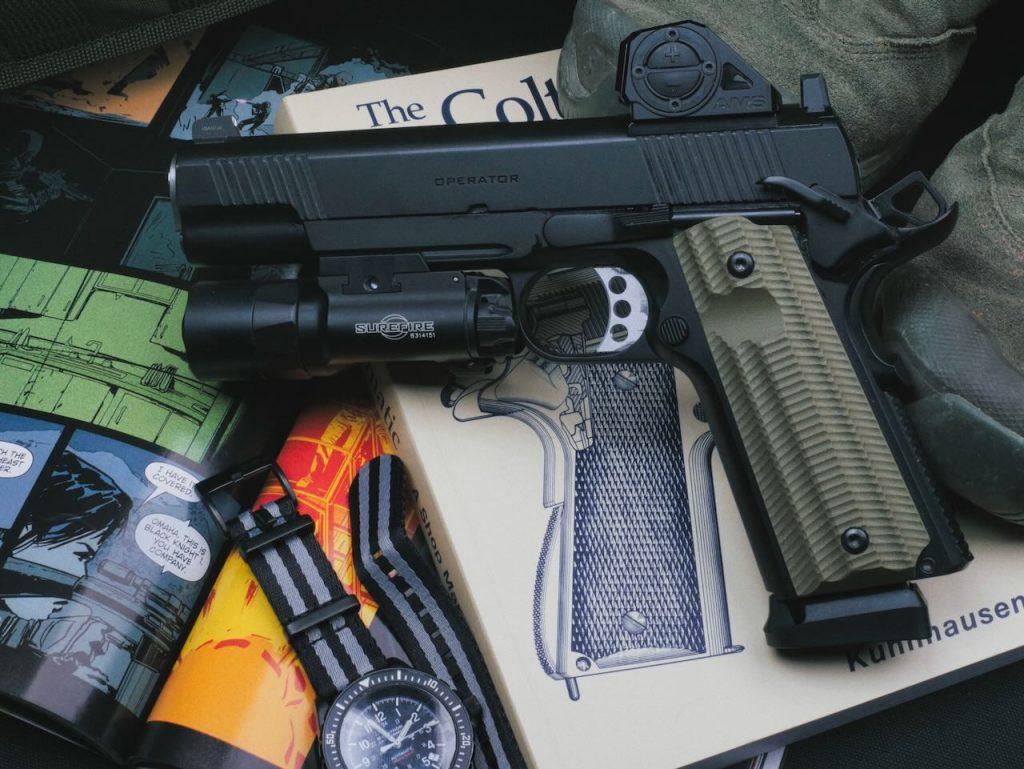



This was incredible helpful! There is ZERO information on the AMS currently besides this, ZERO on the AMSc , I would love to see something like this about the AMSc if possible!
Hey Zan, older comment but I thought I’d come back to it. I was thiiiiiiis close to picking up an AMSc recently to toss on my 1911. I ended up not doing it, though and got a Holosun EPS Carry instead. Mostly just because I wanted to actually try the Holosun since I haven’t spent time with their newer stuff. Having spent a lot of time with the AMS and now also the RMSx, I think I have a pretty good grasp on what I would expect from the AMSc. In short, I think it would work really well and is a good option if you’re avoiding stuff made in China like Holosun. The automatic brightness-only setting on the AMSc is very likely identical to the RMSx. It worked fine, and was responsive enough even when I fired up my Surefire x300T, but I did sometimes feel like I would have been nice to be able to manually juice the power just a bit more, especially indoors, just in case. If you’ve got standard factory height irons, the AMSc would work well with them. I love the clear lenses on all the Shield optics. It’s nice to have no tint whatsoever. I’m still kinda iffy on the elevation and windage adjustments not having any clicks at all, but my experience has shown it to not actually be an issue. I’ve yet to lose zero on anything. In all, if you’re looking for a very compact mini dot for a pistol… Read more »